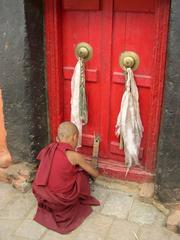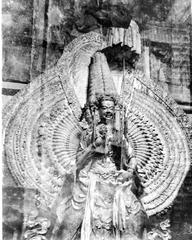Chemrey Monastery Visiting Hours, Tickets, and Guide to Leh Historical Sites
Date: 15/06/2025
Introduction
Chemrey Monastery (Chemrey Gompa) rises majestically amidst the dramatic landscapes of Ladakh, serving as both a spiritual sanctuary and a cultural cornerstone. Established in 1664 CE by Lama Tagsang Raschen under the patronage of King Sengge Namgyal, Chemrey is a significant center of the Drukpa Kagyu order of Tibetan Buddhism. Its hilltop location, intricate murals, rare scriptures, and towering statue of Guru Padmasambhava make it an essential destination for pilgrims, cultural travelers, and history enthusiasts.
This detailed guide presents Chemrey Monastery’s visiting hours, ticket information, accessibility, architectural highlights, travel tips, and insights into the vibrant Chemrey Wangchok festival. Whether you seek spiritual enrichment, artistic marvels, or an authentic Ladakhi experience, this guide ensures a respectful and rewarding visit. For further planning, consult official tourism resources and verified guides (india.com, kashmirhills.com, ekashmirtourism.com).
Historical Background and Founding
Chemrey Monastery was founded during a period of religious resurgence in Ladakh. Lama Tagsang Raschen, a key figure in the proliferation of the Drukpa lineage, established Chemrey with support from King Sengge Namgyal, who was instrumental in consolidating Buddhist institutions throughout the region (india.com). Today, approximately 20 resident monks continue the monastery’s spiritual legacy.
Architectural and Artistic Heritage
Overall Layout
Chemrey Monastery is perched on a hill, with its whitewashed multi-tiered structure blending organically with the rocky terrain. The complex features a central courtyard surrounded by assembly halls (Dukhangs), shrines, residential quarters, and storage rooms (kashmirhills.com).
Assembly Halls (Dukhangs)
There are two Dukhangs:
- The older hall displays portraits of the founder, Lama Tagsang Raschen.
- The newer hall enshrines images of Padmasambhava (Guru Rinpoche), a central figure in Tibetan Buddhism.
Both halls are adorned with vivid 17th-century murals depicting Buddhist cosmology, deities such as Sakyamuni Buddha and Kalachakra, and significant episodes from Buddhist scriptures (india.com).
The Lama Temple (Lha-Khang)
Adjacent to the assembly halls, the Lha-Khang houses revered relics and exquisite murals of Sakyamuni Buddha with his chief disciples, Sariputra and Maudgalyayana. Statues of Avalokiteshvara and Maitreya further enrich this sacred space (indianetzone.com).
Statue of Padmasambhava
A one-storey-high statue of Guru Padmasambhava dominates the main prayer hall, symbolizing his enduring influence in Himalayan Buddhism (kashmirhills.com).
Sacred Scriptures
The monastery preserves a rare set of 29 Buddhist scriptures inscribed in silver and gold letters—testament to its historical role as a center of learning (indianetzone.com).
Monastic Life and Religious Significance
Chemrey Monastery is affiliated with the Drukpa Kagyu order, emphasizing meditation, discipline, and esoteric teachings. The resident monastic community maintains daily rituals, meditation, and study, preserving centuries-old traditions and fostering a sense of spiritual continuity.
Chemrey Wangchok: The Signature Festival
Overview
Chemrey Wangchok (also called Chemrey Angchok) is the monastery’s annual festival, celebrated on the 28th and 29th days of the ninth Tibetan lunar month—typically late November (ekashmirtourism.com; safarmentor.com). The festival honors Guru Padmasambhava and features sacred cham dances, ritual offerings, and collective prayers.
Rituals and Performances
Monks perform cham dances in elaborate costumes and masks representing Buddhist deities and mythological beings. These dances symbolize the triumph of good over evil and the purification of negative energies (tripoto.com). Ritual music, incense, and butter lamp offerings create a vibrant, immersive atmosphere.
Community and Cultural Exchange
Local residents and visitors participate, bringing offerings and sharing in communal feasts. The festival fosters a sense of unity and provides an opportunity for cultural exchange (lifeontheplanetladakh.com).
Practical Visitor Information
Visiting Hours and Tickets
- General Hours: 8:00 AM to 5:00 PM daily. Hours may vary during festivals—confirm in advance.
- Entry Fee: No official fee; donations are appreciated for maintenance.
How to Reach
- By Road: 40–46 km southeast of Leh via taxi, shared jeep, or self-drive. The journey takes about 1–1.5 hours and offers spectacular scenery.
- Trekking: Trekking routes available for experienced hikers.
- Public Transport: Buses from Leh to Chemrey Village, with a short walk to the monastery.
Accessibility
- Terrain: Located on a hilltop with steps and uneven pathways. Not wheelchair accessible; visitors with mobility issues should plan for limited assistance.
Facilities
- Food: Small local stalls offer tea and snacks; full meals available in Leh.
- Accommodation: No onsite lodging; stay in Leh, which offers a range of guesthouses and hotels.
Dress Code and Etiquette
- Dress modestly (covered shoulders and knees).
- Remove hats and shoes before entering prayer halls.
- Maintain silence and be respectful during rituals.
- Ask before photographing interiors or ceremonies.
Duration of Visit
Most visitors spend 1–2 hours exploring the monastery. Allow more time during festivals or for meditation.
Safety, Health, and Responsible Tourism
- Altitude: Acclimatize in Leh for 1–2 days before visiting.
- Weather: Dress in layers; carry sun protection.
- Connectivity: Limited mobile coverage; BSNL post-paid works best.
- Eco-Tips: Use reusable bottles, dispose of waste responsibly, and respect local customs.
Nearby Attractions
- Hemis Monastery: Largest monastery in Ladakh, renowned for cham dances and festivals.
- Thiksey Monastery: Famous for its architecture and giant Maitreya Buddha statue.
- Shey Palace: Historic former royal palace.
- Pangong Lake: Iconic high-altitude lake accessible by scenic drive.
Chemrey Wangchok Festival: Visitor Guide
- Dates: 28th–29th days of the ninth Tibetan month (late November; in 2025, around Nov 28–29) (ekashmirtourism.com).
- Tickets: Free entry; donations welcome.
- Transport: Hire taxis from Leh; check road conditions due to possible snow (tripxl.com).
- Accommodation: Stay in Leh; nearest budget hotels 18 km away (india.com).
- Photography: Permitted with respect for monastic guidelines.
- Food: Local snacks available; bring essentials.
Frequently Asked Questions (FAQ)
Q: What are Chemrey Monastery’s opening hours?
A: 8:00 AM to 5:00 PM daily; check for changes during festivals.
Q: Is there an entry fee?
A: No; donations are appreciated.
Q: Can I take photographs inside?
A: Allowed in some areas; ask before photographing prayer halls or ceremonies.
Q: Is the monastery accessible for people with disabilities?
A: The terrain is challenging; limited assistance available.
Q: What is the best time to visit?
A: May to September for weather; late November for Chemrey Wangchok festival.
Q: How do I get to Chemrey Monastery?
A: By taxi, shared jeep, or bus from Leh; about 1–1.5 hours’ drive.
Visuals and Interactive Elements
Enhance your planning with high-quality images of Chemrey’s murals, Padmasambhava statue, and festival scenes. Use interactive maps to locate the monastery in relation to Leh and other sites. Virtual tours may be available on select travel platforms.
Summary
Chemrey Monastery is a living testament to Ladakh’s vibrant Buddhist heritage. Its historical significance, architectural splendor, rare scriptures, and the evocative Chemrey Wangchok festival offer visitors a unique window into the spiritual and cultural rhythms of the Himalayas. By following practical advice on visiting hours, routes, etiquette, and responsible tourism, travelers can experience this sacred site respectfully and meaningfully. For the latest travel updates and cultural insights, download the Audiala app and explore trusted tourism platforms (india.com, tripoto.com).
References and Sources
- Chemrey Monastery Visiting Guide: History, Architecture, and Practical Tips for Visitors, 2025, India.com
- Chemrey Monastery Visiting Hours, Tickets, and Architectural Highlights in Leh, 2025, Kashmir Hills
- Chemrey Monastery Festival Guide: Visiting Hours, Tickets & Ladakh Cultural Events, 2025, Ekashmir Tourism
- Chemrey Monastery Festival Guide: Visiting Hours, Tickets & Ladakh Cultural Events, 2025, SafarMentor
- Chemrey Monastery Festival Guide: Visiting Hours, Tickets & Ladakh Cultural Events, 2025, Tripoto

